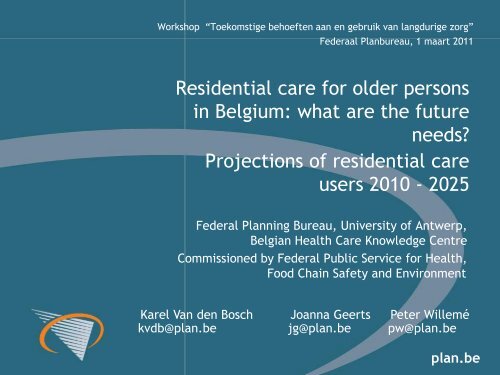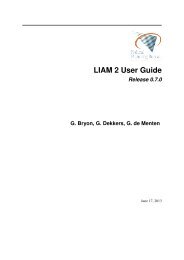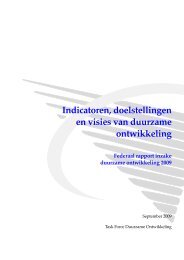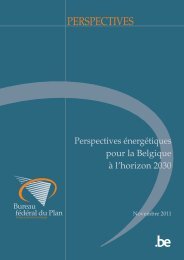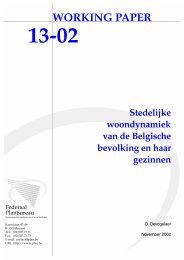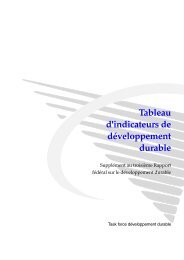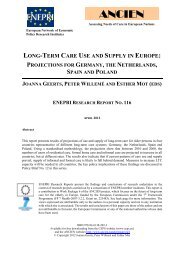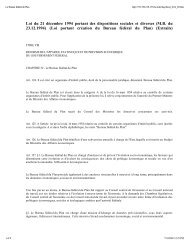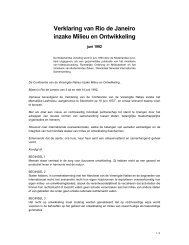Residential care for older persons in Belgium: what are the future ...
Residential care for older persons in Belgium: what are the future ...
Residential care for older persons in Belgium: what are the future ...
You also want an ePaper? Increase the reach of your titles
YUMPU automatically turns print PDFs into web optimized ePapers that Google loves.
Workshop “Toekomstige behoeften aan en gebruik van langdurige zorg”Federaal Planbureau, 1 maart 2011<strong>Residential</strong> <strong>c<strong>are</strong></strong> <strong>for</strong> <strong>older</strong> <strong>persons</strong><strong>in</strong> <strong>Belgium</strong>: <strong>what</strong> <strong>are</strong> <strong>the</strong> <strong>future</strong>needs?Projections of residential <strong>c<strong>are</strong></strong>users 2010 - 2025Federal Plann<strong>in</strong>g Bureau, University of Antwerp,Belgian Health C<strong>are</strong> Knowledge CentreCommissioned by Federal Public Service <strong>for</strong> Health,Food Cha<strong>in</strong> Safety and EnvironmentK<strong>are</strong>l Van den Bosch Joanna Geerts Peter Willemékvdb@plan.be jg@plan.be pw@plan.beplan.be
Policy background• Successive protocol agreements between federal andregional authorities (1997, 2003, 2005)• Aims (<strong>in</strong>ter alia):Moratorium on <strong>the</strong> number of beds <strong>in</strong> residential <strong>c<strong>are</strong></strong>Substitution of higher <strong>c<strong>are</strong></strong> nurs<strong>in</strong>g beds (MRS/RVT) <strong>for</strong> lower <strong>c<strong>are</strong></strong>beds (ROB/MRPA)Allow <strong>older</strong> people to stay at home• Moratorium was due to expire on 1 October 2011But has been extendedplan.be
Policy backgroundRecent trends <strong>in</strong> supply of residential <strong>c<strong>are</strong></strong>: overall stability,substition of nurs<strong>in</strong>g home beds <strong>for</strong> beds <strong>in</strong> homes <strong>for</strong> <strong>the</strong> elderlyYearNurs<strong>in</strong>ghomesHomes <strong>for</strong><strong>the</strong>elderlyTotalbedsBeds/1000<strong>persons</strong>65+ yearsBeds/1000<strong>persons</strong>75+ years2000 33 103 87 940 121 043 71 1642001 37 489 85 055 122 544 71 1622002 39 403 85 350 124 753 71 1602003 45 306 79 139 124 445 71 1562004 46 905 78 068 124 973 70 1542005 47 165 77 917 125 243 70 1502006 48 712 76 406 125 279 69 1462007 51 442 73 941 125 539 69 1422008 54 796 71 963 126 916 70 1402009 59 504 68 760 128 421 70 1392010 63 064 66 179 129 400 70 1382011 65 325 64 255 129 732 n.a. n.a.plan.be
Policy backgroundRecent trends <strong>in</strong> home <strong>c<strong>are</strong></strong> (Flanders only): expansionUsers of homenurs<strong>in</strong>g – 60+Users/1000<strong>persons</strong>60+Householdsreceiv<strong>in</strong>gYearfamily <strong>c<strong>are</strong></strong> a2000 107 985 48.2 62 6292001 112 029 49.8 63 2252002 n.a. 0 65 8702003 n.a. 0 67 0052004 133 119 58.7 67 7252005 126 037 55 70 1122006 131 091 56.6 74 4062007 136 832 57.9 79 1812008 140 851 58.5 n.a.2009 148 039 60.4 n.a.2010 152 802 61.3 n.a.2011 157 280 n.a. n.a.plan.be
Policy backgroundAlternative <strong>for</strong>ms of LTC <strong>are</strong> expand<strong>in</strong>g but still marg<strong>in</strong>alShort stay centresBeds(absolutenumbers)Beds/1000<strong>persons</strong> 75+yearsDay <strong>c<strong>are</strong></strong> centresPlaces(absolutenumbers)Places/1000<strong>persons</strong> 75+yearsYear2000 241 0.3 713 12001 267 0.4 793 12002 333 0.4 856 1.12003 408 0.5 1 088 1.42004 558 0.7 1 259 1.52005 749 0.9 1 395 1.72006 916 1.1 1 438 1.72007 1 103 1.2 1 577 1.82008 1 262 1.4 1 648 1.82009 1 401 1.5 1 747 1.92010 1 626 1.7 1 830 1.92011 1 757 n.a. 1 881 n.a.plan.be
Demographic background:Number of <strong>persons</strong> by age group and year400000035000003000000250000020000001500000100000050000002000 2004 2008 2012 2016 2020 2024 2028 2032 2036 2040 2044 2048 2052 2056 206065-69 70-74 75-79 80-84 85-89 90-94 95+• Strong <strong>in</strong>crease <strong>in</strong> number of 65+ from 2010 on• Increase <strong>in</strong> number of 80+ accelerates after 2025plan.be
Research aim• Projection of <strong>the</strong> number of <strong>older</strong> <strong>persons</strong> (65+) us<strong>in</strong>gresidential <strong>c<strong>are</strong></strong> up to 2025Research steps• Literature review• Determ<strong>in</strong>ants of <strong>c<strong>are</strong></strong> needs (ADL disability)• Determ<strong>in</strong>ants of entry <strong>in</strong>to residential <strong>c<strong>are</strong></strong>• Projection models of residential <strong>c<strong>are</strong></strong>• Selection of databases• Health Interview by Survey (HIS) 2004 , 2008• Permanent Sample (EPS) 2004-2009• Design of projection model• Estimation of equations• Projectionplan.be
Projection model set-up: ma<strong>in</strong> variablesA. Demography: Age and SexC.Household situation: maritalstatus, presence of childrenB.Chronic conditionsAvailability of <strong>in</strong><strong>for</strong>mal<strong>c<strong>are</strong></strong>Disability: ADL limitations(Need <strong>for</strong> <strong>c<strong>are</strong></strong>)Formal home <strong>c<strong>are</strong></strong>D. Use of <strong>for</strong>mal <strong>c<strong>are</strong></strong><strong>Residential</strong> <strong>c<strong>are</strong></strong>Supply of<strong>for</strong>mal <strong>c<strong>are</strong></strong>Regionalvariationplan.be
Transition model database 1: EPSMa<strong>in</strong> database: Echantillon Permanent(e) Steekproef (EPS)• Adm<strong>in</strong>istrative panel, anonymised, 2002-2009• Sample of population <strong>in</strong> Belgian public health <strong>in</strong>surance• 1/40 of <strong>persons</strong> < 65• 1/20 of <strong>persons</strong> 65+• Data on use of public health <strong>c<strong>are</strong></strong> and related variables• Also on liv<strong>in</strong>g situation• Not on health and disability itself!• Data used <strong>in</strong> this project restricted to:• Population aged 65+• Years 2004-2009plan.be
Transition model database 1: EPS• Five chronic conditions, which <strong>are</strong> predictors of disability, could beidentified <strong>in</strong> <strong>the</strong> EPS us<strong>in</strong>g data on medication and medicaltreatments:Name Impact PrevalenceCOPD moderate highDementia very high moderateDiabetes moderate highHip fracture high lowPark<strong>in</strong>son’s disease very high low• Disability (1 or more limitation <strong>in</strong> ADL) imputed, us<strong>in</strong>g equationestimated with HIS 2004 & 2008plan.be
Transition model database 2: HIS 2004 & 2008Additional data-base: Health Interview Survey 2004 & 2008• Large survey on health, health problems and health behavior• Sample from population of Belgian residents• Includ<strong>in</strong>g <strong>in</strong>stitutionalized population• Oversampl<strong>in</strong>g of <strong>persons</strong> 65+ (2004) ; 75+ (2008)• Sample sizes (65+) 3594 (2004); 2859 (2008)• Logistic model of disability (1 or more limitations <strong>in</strong> ADL)• Us<strong>in</strong>g age, sex, prov<strong>in</strong>ce and five chronic conditions as predictorsplan.be
Transition model database 2: HIS 2004 & 2008Age is dom<strong>in</strong>ant predictor of disability: % with disability by age60%Male 2004 Male 2008 Female 2004 Female 200850%40%30%20%10%0%65-69 70-74 75-79 80-84 85-89 90-94 95+plan.be
Transition model of LTC useModel of transitions between LTC situations.• Quarterly• C<strong>are</strong>ful def<strong>in</strong>ition of <strong>c<strong>are</strong></strong> situations: Each <strong>in</strong>dividual <strong>in</strong> anyquarter had to be assigned to a s<strong>in</strong>gle <strong>c<strong>are</strong></strong> situation• Determ<strong>in</strong>ants: age, sex, probability of disability, liv<strong>in</strong>gsituation, prov<strong>in</strong>ceLiv<strong>in</strong>g situation:• partner• daugher, son• o<strong>the</strong>r <strong>persons</strong>• dist<strong>in</strong>ction between present / present but available <strong>for</strong><strong>in</strong><strong>for</strong>mal <strong>c<strong>are</strong></strong> / not present• Set of hierarchical transition probability modelsplan.be
Transition model: LTC situations• no long-term <strong>c<strong>are</strong></strong>, no hospitalization• home-<strong>c<strong>are</strong></strong> use ‘low’ <strong>in</strong>tensity (categories A, T)• home-<strong>c<strong>are</strong></strong> use ‘high <strong>in</strong>tensity’ (categories B, C),• residential <strong>c<strong>are</strong></strong>, cat. O: 0 ADL limitations• residential <strong>c<strong>are</strong></strong>, cat. A: 1-2 ADL lim’s or ‘disoriented’• residential <strong>c<strong>are</strong></strong>, cat. B*: 3-4 ADL lim’s or ‘disoriented’ and 1-2 ADL lim’s• residential <strong>c<strong>are</strong></strong>, cat. C*: 5-6 ADL lim’s, not ‘disoriented’• residential <strong>c<strong>are</strong></strong>, cat. Cd*: 5-6 ADL lim’s and ‘disoriented’• hospitalization• Deceased* Dist<strong>in</strong>ction between ROB/MRPA and RVT/MRS collapsedplan.be
Transitions <strong>in</strong> LTC situations after one year: descriptive4 quarters No <strong>c<strong>are</strong></strong> Home<strong>c<strong>are</strong></strong> lowHome<strong>c<strong>are</strong></strong>highResid.<strong>c<strong>are</strong></strong>level OResid.<strong>c<strong>are</strong></strong>level AResid.<strong>c<strong>are</strong></strong>level B*Resid.<strong>c<strong>are</strong></strong>level C*Resid.<strong>c<strong>are</strong></strong>level Cd*HospitalizationTotalNo <strong>c<strong>are</strong></strong> 93.4 7.4 4.4 1.6 0.6 0.5 0.2 0.2 31.8 81.2Home <strong>c<strong>are</strong></strong> low 1.9 66.8 5.9 0.3 0.4 0.4 0.2 0.0 9.5 5.3Home <strong>c<strong>are</strong></strong> high 0.4 5.6 57.6 0.1 0.1 0.1 0.3 0.2 4.8 1.5Resid. <strong>c<strong>are</strong></strong> level O 0.2 0.8 0.2 65.7 7.0 2.3 0.7 0.1 2.7 1.2Resid. <strong>c<strong>are</strong></strong> level A 0.2 1.7 0.7 10.6 49.9 5.8 2.2 0.5 3.2 1.1Resid. <strong>c<strong>are</strong></strong> level B* 0.3 2.6 2.3 6.4 15.8 48.5 5.0 1.9 5.0 1.4Resid. <strong>c<strong>are</strong></strong> level C* 0.1 1.0 2.2 2.0 4.4 6.0 48.7 1.4 3.0 0.7Resid. <strong>c<strong>are</strong></strong> level Cd* 0.2 1.5 3.1 1.9 4.7 15.2 12.6 60.2 4.8 1.8Hospitalization 0.7 2.5 2.1 1.0 1.0 0.9 0.8 0.5 12.9 0.9Deceased 2.7 10.3 21.4 10.5 16.2 20.3 29.4 35.0 22.4 4.9Total 100.0 100.0 100.0 100.0 100.0 100.0 100.0 100.0 100.0 100.0% <strong>in</strong> orig<strong>in</strong> category 86.1% 5.1% 1.5% 1.3% 1.1% 1.4% 0.8% 1.8% 1.0% 100.0%plan.be
Transition model: hierarchical structureInitial situationP(Deceased)P(Survived)P(Hospitalised)P(Not hospitalised)P(At home)P(<strong>Residential</strong>)P(No <strong>c<strong>are</strong></strong>) P(Home <strong>c<strong>are</strong></strong>) P(O) P(A) P(B) P(C) P(Cd)P(Low <strong>c<strong>are</strong></strong>)P(High <strong>c<strong>are</strong></strong>)plan.be
Transition model: resultsProbability of transition <strong>in</strong>to residential <strong>c<strong>are</strong></strong>, from a situationof no <strong>c<strong>are</strong></strong>, by risk of disability, <strong>for</strong> four types of <strong>persons</strong>, byquarter3.0%2.5%2.0%1.5%1.0%0.5%0.0%0 0.04 0.08 0.12 0.16 0.2 0.24 0.28 0.32 0.36 0.4Women, aged 70-74, MarriedWomen, aged 70-74, S<strong>in</strong>gleWomen, aged 90-94, MarriedWomen, aged 90-94, S<strong>in</strong>gleplan.be
Model of transitions <strong>in</strong> LTC: results• Disability is dom<strong>in</strong>ant predictor• O<strong>the</strong>r important predictors: age, presence partner or child <strong>in</strong>household• Disability is itself largely determ<strong>in</strong>ed by age• Important differences between prov<strong>in</strong>ces (not alwayssignificant)• But difficult to <strong>in</strong>terpretplan.be
Transition & projection model limitations• Not all relevant data <strong>are</strong> available• Level of disability (number of ADL limitations)• In<strong>for</strong>mal <strong>c<strong>are</strong></strong> from outside <strong>the</strong> household• Income, education, home ownership• Formal LTC not paid by INAMI / RIZIV (home <strong>c<strong>are</strong></strong>)• No data on local variations <strong>in</strong> supply of <strong>c<strong>are</strong></strong> (wait<strong>in</strong>g lists?)• Data limited to 2004-09, not possible to identify time trends• No projections <strong>for</strong> <strong>Belgium</strong> <strong>for</strong> disability or chronicconditionsplan.be
Projection methodCell-based macro-projection model• Cells def<strong>in</strong>ed by• Year (2010 – 2025)• Age category (5 year <strong>in</strong>tervals)• Sex• Prov<strong>in</strong>ce+• Liv<strong>in</strong>g situation (4 variables)• Chronic conditions (5 variables)• Variables <strong>in</strong> each cell• Number <strong>in</strong> population• Risk (%) of disability• % <strong>in</strong> each LTC situation• Projection results by aggregation across cells, weighted by number<strong>in</strong> population• Calibration to 2010 total accord<strong>in</strong>g to RIZIV data (125.500)•Necessary because of residential <strong>c<strong>are</strong></strong> ‘immigrants’plan.be
Projection method: set-up of projection matrix• Population projections by FPB – ADSEI• Year x Age x Sex x Prov<strong>in</strong>ce+• Projection of liv<strong>in</strong>g situations by Michel Poula<strong>in</strong>• Year x Age x Sex x Liv<strong>in</strong>g situation• Liv<strong>in</strong>g situation <strong>in</strong> base year from EPS• Some <strong>in</strong>terpolation and calibration necessary• Chronic conditions from EPS• Chronic conditions x Age x Sex x Prov<strong>in</strong>ce• Assumed unchanged across projection period <strong>in</strong> base scenario• But adapted <strong>in</strong> o<strong>the</strong>r scenarios• Risk of disability• Imputed us<strong>in</strong>g equation estimated on HIS• Proportion <strong>in</strong> each <strong>c<strong>are</strong></strong> situation• Imputed us<strong>in</strong>g equations estimated on EPS• Cf. block diagram <strong>in</strong> handoutplan.be
Projection results: base scenarioNumber (left scale)Prevalence (right scale)170.0008.0%160.000150.0007.5%140.000130.0007.0%120.0006.5%110.000100.0006.0%plan.be
Projection results by prov<strong>in</strong>ce+: base scenarioNumber of<strong>persons</strong> <strong>in</strong>residential <strong>c<strong>are</strong></strong>Increase <strong>in</strong>% % aged 85+2010 2025 2025 / 2010 2010 2025Antwerpen-Mechelen 15 294 19 563 28% 12.9% 15.0%Turnhout 3 472 6 142 77% 9.7% 13.0%Brussels 12747 12 223 -4% 16.2% 14.2%Halle-Vilvoorde 6 118 8 843 45% 11.9% 14.7%Leuven 4 824 7 069 47% 12.4% 14.8%Nivelles 4 111 6 082 48% 13.1% 13.7%West-Vlaanderen-Kust 7 772 11 711 51% 12.1% 14.1%West-Vlaanderen-B<strong>in</strong>nen 7 461 10 494 41% 12.6% 16.2%Gent-Aalst 9 430 13 138 39% 12.4% 15.5%Oost-Vlaanderen-rest 9 065 12 766 41% 11.9% 14.7%Charleroi-Mons-Soignies 10 471 11 753 12% 13.4% 12.3%Ha<strong>in</strong>aut-autre 7 211 8 706 21% 14.4% 13.9%Liège 14 195 17 186 21% 12.8% 13.1%Limburg 5 571 10 390 87% 9.6% 13.0%Luxembourg 2 745 3 401 24% 12.9% 13.2%Namur-Namur 3 531 4 619 31% 13.1% 13.3%Namur-autre 1 481 1 944 31% 13.0% 13.0%<strong>Belgium</strong>-total 125 500 166 000 32% 12.6% 14.1%plan.be
Projection results: base scenario• Results driven by age<strong>in</strong>g of <strong>the</strong> population• Due to importance of age, constant risk of disability, and constanttransition probabilities between <strong>c<strong>are</strong></strong> situations• Important differences between prov<strong>in</strong>ces <strong>in</strong> <strong>the</strong> projectednumber of users of residential <strong>c<strong>are</strong></strong>• Due to variation <strong>in</strong> demographic composition:• Some prov<strong>in</strong>ces with few 85+ now will experience strong age<strong>in</strong>geffect <strong>in</strong> near <strong>future</strong>plan.be
Projection results: six alternative scenariosThree alternative scenarios on disability1.“Better education”: <strong>the</strong> prevalence of chronic conditionsdecl<strong>in</strong>es <strong>in</strong> l<strong>in</strong>e with <strong>the</strong> <strong>in</strong>creased educational level of eachnew cohort of <strong>older</strong> <strong>persons</strong>2.“Morbidity compression” : <strong>the</strong> risk of disability by age and sexwill decrease <strong>in</strong> <strong>future</strong>, <strong>in</strong> <strong>the</strong> sense that half of <strong>the</strong> projected<strong>in</strong>creases <strong>in</strong> longevity <strong>are</strong> assumed to be spent free of disability3.“ Diabetes epidemic” <strong>the</strong> prevalence of diabetes will <strong>in</strong>creaseby 5% annually dur<strong>in</strong>g <strong>the</strong> projection periodplan.be
Projection results: six alternative scenariosProjected trends <strong>in</strong> use of residential <strong>c<strong>are</strong></strong> accord<strong>in</strong>g to fourscenarios on disability180.000"Unchanged disability""Diabetes epidemic""Better education""Morbidity compression"170.000160.000150.000140.000130.000120.0002010 2011 2012 2013 2014 2015 2016 2017 2018 2019 2020 2021 2022 2023 2024 2025plan.be
Projection results: six alternative scenariosTwo alternative scenarios on liv<strong>in</strong>g situation4. “Pure demographic”: liv<strong>in</strong>g situation of <strong>older</strong> <strong>persons</strong> by ageand sex group will not change dur<strong>in</strong>g <strong>the</strong> projection period5. “Fewer children”: <strong>the</strong> number of children liv<strong>in</strong>g with <strong>the</strong>ir<strong>older</strong> p<strong>are</strong>nts will be halved dur<strong>in</strong>g <strong>the</strong> projection periodOne alternative scenario on home <strong>c<strong>are</strong></strong>6. “Home <strong>c<strong>are</strong></strong>”: home <strong>c<strong>are</strong></strong> expands by 50 % (beyond <strong>what</strong> isrequired by <strong>the</strong> age<strong>in</strong>g of <strong>the</strong> population).plan.be
Projected trends <strong>in</strong> use of residential <strong>c<strong>are</strong></strong> accord<strong>in</strong>g to threescenarios on liv<strong>in</strong>g situation180000Projection results: six alternative scenarios"Pure demographic" "Fewer children" "Base"1700001600001500001400001300001200002010 2011 2012 2013 2014 2015 2016 2017 2018 2019 2020 2021 2022 2023 2024 2025plan.be
Projection results: six alternative scenariosBase scen."Home <strong>c<strong>are</strong></strong> scen."170.000165.000160.000155.000150.000145.000140.000135.000130.000125.000120.0002010 2011 2012 2013 2014 2015 2016 2017 2018 2019 2020 2021 2022 2023 2024 2025plan.be
20102011201220132014201520162017201820192020202120222023202420252026202720282029203020312032203320342035203620372038203920402041204220432044204520462047204820492050Policy implicationsProjection up to 2050, accord<strong>in</strong>g to “pure demographic” scenario320.000Number <strong>in</strong> residential <strong>c<strong>are</strong></strong>300.000280.000260.000240.000220.000200.000180.000160.000140.000120.000plan.be
Possible alternatives?• Limit entry <strong>in</strong>to residential <strong>c<strong>are</strong></strong> at level O• Currently 23 000 <strong>older</strong> <strong>persons</strong> <strong>in</strong> category MR/ROB O, who mostly<strong>are</strong> not really need<strong>in</strong>g residential <strong>c<strong>are</strong></strong> (based on <strong>the</strong>ir ADL disability)• Beds could be used <strong>for</strong> <strong>older</strong> <strong>persons</strong> need<strong>in</strong>g more <strong>in</strong>tensive levelsof <strong>c<strong>are</strong></strong>• This will require alternative <strong>c<strong>are</strong></strong> <strong>for</strong> <strong>persons</strong> now <strong>in</strong> residential<strong>c<strong>are</strong></strong> level O• Due to age<strong>in</strong>g of <strong>the</strong> population, home <strong>c<strong>are</strong></strong> will have to expandanyway, roughly <strong>in</strong> <strong>the</strong> same proportion as residential <strong>c<strong>are</strong></strong>• The expansion of both types of <strong>c<strong>are</strong></strong> will require additionalqualified personnel, if quality is to be ma<strong>in</strong>ta<strong>in</strong>edplan.be


